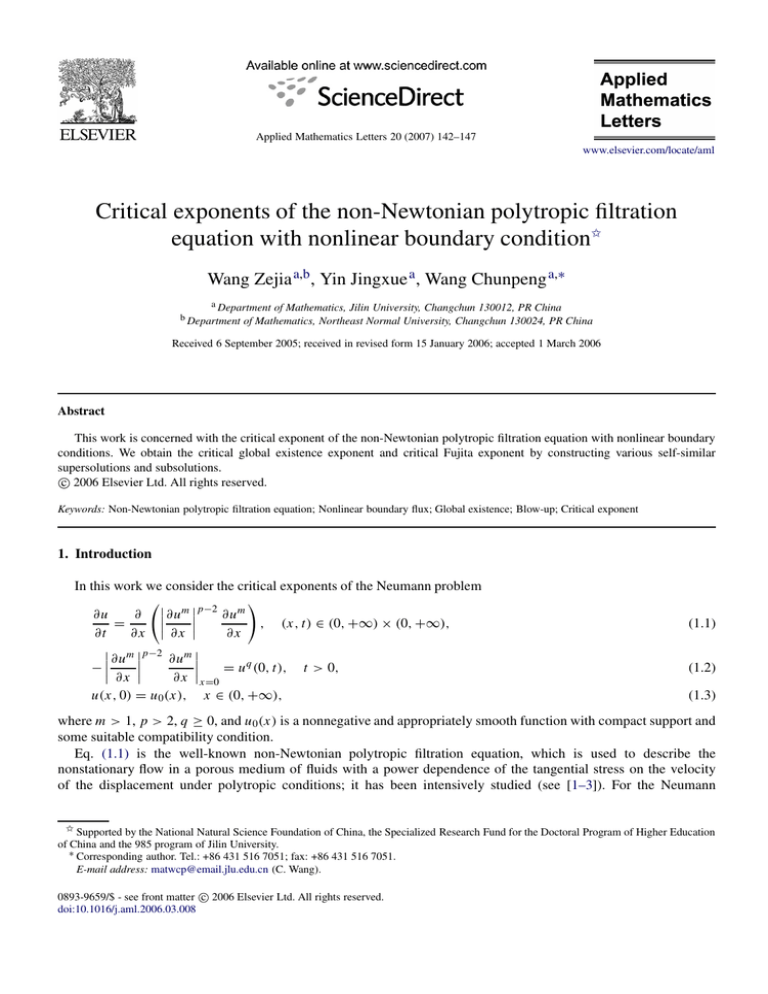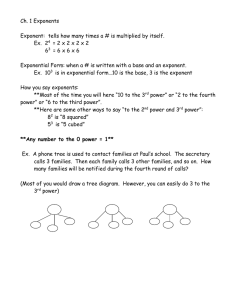
Applied Mathematics Letters 20 (2007) 142–147
www.elsevier.com/locate/aml
Critical exponents of the non-Newtonian polytropic filtration
equation with nonlinear boundary condition✩
Wang Zejia a,b , Yin Jingxue a , Wang Chunpeng a,∗
a Department of Mathematics, Jilin University, Changchun 130012, PR China
b Department of Mathematics, Northeast Normal University, Changchun 130024, PR China
Received 6 September 2005; received in revised form 15 January 2006; accepted 1 March 2006
Abstract
This work is concerned with the critical exponent of the non-Newtonian polytropic filtration equation with nonlinear boundary
conditions. We obtain the critical global existence exponent and critical Fujita exponent by constructing various self-similar
supersolutions and subsolutions.
c 2006 Elsevier Ltd. All rights reserved.
Keywords: Non-Newtonian polytropic filtration equation; Nonlinear boundary flux; Global existence; Blow-up; Critical exponent
1. Introduction
In this work we consider the critical exponents of the Neumann problem
∂u
∂ ∂u m p−2 ∂u m
=
, (x, t) ∈ (0, +∞) × (0, +∞),
∂t
∂x ∂x ∂x
m p−2
∂u ∂u m −
= u q (0, t), t > 0,
∂x ∂ x x=0
u(x, 0) = u 0 (x), x ∈ (0, +∞),
(1.1)
(1.2)
(1.3)
where m > 1, p > 2, q ≥ 0, and u 0 (x) is a nonnegative and appropriately smooth function with compact support and
some suitable compatibility condition.
Eq. (1.1) is the well-known non-Newtonian polytropic filtration equation, which is used to describe the
nonstationary flow in a porous medium of fluids with a power dependence of the tangential stress on the velocity
of the displacement under polytropic conditions; it has been intensively studied (see [1–3]). For the Neumann
✩ Supported by the National Natural Science Foundation of China, the Specialized Research Fund for the Doctoral Program of Higher Education
of China and the 985 program of Jilin University.
∗ Corresponding author. Tel.: +86 431 516 7051; fax: +86 431 516 7051.
E-mail address: matwcp@email.jlu.edu.cn (C. Wang).
c 2006 Elsevier Ltd. All rights reserved.
0893-9659/$ - see front matter doi:10.1016/j.aml.2006.03.008
Z. Wang et al. / Applied Mathematics Letters 20 (2007) 142–147
143
problem (1.1)–(1.3), the local in time existence and the comparison principle of nonnegative weak solutions have
been established; see, e.g., the survey [2].
In this work, we are interested in the large time behavior of solutions of the Neumann problem (1.1)–(1.3) and
investigate the critical global existence exponent q0 and the critical Fujita exponent qc . Namely, we will prove that the
solutions of the problem (1.1)–(1.3) have the following properties:
(i) If 0 ≤ q ≤ q0 , then each solution exists globally.
(ii) If q0 < q < qc , then each nontrivial solution blows up in a finite time.
(iii) If q > qc , then there exist both nontrivial global and nonglobal solutions with small and large u 0 , respectively.
The study of critical exponents was begun in 1966 by Fujita in [4], where the author investigated the critical
exponent of the Cauchy problem for some semilinear equation. From then on, many similar results were established
for different problems of different nonlinear evolution equations; see the survey papers [5,6] and the references therein.
Among those, [7–10] are concerned with the equations with nonlinear boundary flux. In particular, Galaktionov and
Levine [8] considered the problem (1.1)–(1.3) with the case m ≥ 1, p = 2 and the case m = 1, p > 2, and proved
q0 = (m + 1)/2,
qc = m + 1 and q0 = 2( p − 1)/ p,
qc = 2( p − 1)
respectively. It seems to be a natural extension of Galaktionov and Levine [8] to consider the problem (1.1)–(1.3) with
m > 1, p > 2 and it is shown in this work that
q0 = (m + 1)( p − 1)/ p,
qc = (m + 1)( p − 1).
2. Main results and their proofs
The main results of the work are the following four theorems. We first state the global existence case.
Theorem 1. If 0 ≤ q ≤ q0 , then each solution of the problem (1.1)–(1.3) exists globally.
Proof. Let
u(x, t) = eβ(T +t ) h(ξ ),
ξ=
x
with T > 0, β > 0 and h(ξ ) satisfying
|(h m ) | p−2 (h m ) (ξ ) + β(m − (m + 1)/ p)ξ h (ξ ) − βh(ξ ) = 0,
m p−2
−|(h ) |
m (2.1)
eβ(m−(m+1)/ p)(T +t )
ξ > 0,
(h ) (0) = h (0).
q0
(2.2)
(2.3)
By the fixed point theorem, it may be shown that there exists a unique nonnegative and nontrivial solution of the
problem (2.2) and (2.3) and the solution has compact support. Choose T > 0 sufficiently large that u(x, 0) ≥ u 0 (x)
and u(0, t) ≥ 1. Then for any 0 ≤ q ≤ q0 , u is a supersolution of the problem (1.1)–(1.3) and the comparison
principle implies that
u(x, t) ≤ u(x, t),
(x, t) ∈ (0, +∞) × (0, +∞),
which yields that u(x, t) exists globally.
Now we consider the blow-up cases.
Theorem 2. If q > q0 , then the solution of the problem (1.1)–(1.3) with appropriately large initial data blows up in
a finite time.
Proof. Let
u(x, t) = (T − t)−( p−1)/[ pq−( p−1)(m+1)] f (η),
η = x(T − t)[m( p−1)−q]/[ pq−( p−1)(m+1)]
with T > 0. It is easy to see that if for η ∈ {η > 0 | f (η) ≥ 0}, f (η) satisfies
q − m( p − 1)
p−1
η f (η) −
f (η) ≥ 0
|( f m ) | p−2 ( f m ) (η) −
pq − ( p − 1)(m + 1)
pq − ( p − 1)(m + 1)
(2.4)
(2.5)
144
Z. Wang et al. / Applied Mathematics Letters 20 (2007) 142–147
and
−|( f m ) | p−2 ( f m ) (0) ≤ f q (0),
(2.6)
then u(x, t) is a subsolution of the problem (1.1)–(1.3) with appropriately large u 0 .
We claim that the problem (2.5) and (2.6) admits a solution of the form
( p−1)/[m( p−1)−1]
f (η) = A(a − η)+
,
(2.7)
where A > 0 and a > 0 are constants to be determined. Noticing
p−1
(a − η)( p−1)/[m( p−1)−1]−1,
m( p − 1) − 1
m( p − 1)
Am (a − η)1/[m( p−1)−1],
( f m ) (η) = −
m( p − 1) − 1
p
p−1
|( f m ) | p−2 ( f m ) (η) = (m Am ) p−1
(a − η)( p−1)/[m( p−1)−1]−1,
m( p − 1) − 1
f (η) = −
we see that (2.5) is valid if
p
( p − 1)(q − 1)
( p − 1)a
p−1
p−1 m( p−1)−1
η+m
≥ 0.
A
−
pq − (m + 1)( p − 1)
m( p − 1) − 1
pq − (m + 1)( p − 1)
Since q p > (m + 1)( p − 1), the coefficient of η is positive and thus the above inequality holds provided that
p
( p − 1)a
p−1
m p−1 Am( p−1)−1
.
≥
m( p − 1) − 1
pq − (m + 1)( p − 1)
(2.8)
One can see that (2.6) holds if
p−1
m( p − 1)
m( p−1)
A
a ( p−1)/[m( p−1)−1] ≤ Aq a q( p−1)/[m( p−1)−1],
m( p − 1) − 1
i.e.,
m( p − 1)
m( p − 1) − 1
p−1
≤ Aq−m( p−1) a (q−1)( p−1)/[m( p−1)−1].
(2.9)
Taking a = c Am( p−1)−1 with c > 0, we can rewrite (2.8) and (2.9) as
p
( p − 1)c
p−1
p−1
m
,
≥
m( p − 1) − 1
pq − (m + 1)( p − 1)
and
A pq−(m+1)( p−1)c(q−1)( p−1)/[m( p−1)−1] ≥
m( p − 1)
m( p − 1) − 1
p−1
.
Because q p > (m + 1)( p − 1), choosing
p−1
m( p − 1)
pq − (m + 1)( p − 1)
0<c<
m( p − 1) − 1
m( p − 1) − 1
and A > 0 large enough, we see that (2.8) and (2.9) are both valid.
Thus, u(x, t) given by (2.4) and (2.7) is a weak subsolution of the problem (1.1)–(1.3) with appropriately large u 0 .
The comparison principle implies that u(x, t) ≤ u(x, t) in (0, +∞) × (0, T ), and thus u(x, t) blows up in a finite
time. Theorem 3. If q0 < q < qc , then each nontrivial solution of the problem (1.1)–(1.3) blows up in a finite time.
Z. Wang et al. / Applied Mathematics Letters 20 (2007) 142–147
145
Proof. Let
u B (x, t) = (τ + t)−1/[( p−1)(m+1)] g(ζ ),
ζ = (τ + t)−1/[( p−1)(m+1)] x
(2.10)
where τ ≥ 0 and
( p−1)/[m( p−1)−1]
g(ζ ) = Cm, p c p/( p−1) − ζ p/( p−1)
(2.11)
+
with c > 0 and
Cm, p =
1
( p − 1)(m + 1)
m( p − 1) − 1
mp
p−1 1/[m( p−1)−1]
.
It is easy to verify that g (0) = 0 and for ζ ∈ {ζ > 0 | g(ζ ) ≥ 0}, g(ζ ) satisfies
1
1
|(g m ) | p−2 (g m ) (ζ ) +
ζ g (ζ ) +
g(ζ ) = 0.
( p − 1)(m + 1)
( p − 1)(m + 1)
By using the well-known properties of weak solutions of the problem (1.1)–(1.3), we deduce that there exists t0 ≥ 0
such that u(0, t0 ) > 0. Therefore, there exist sufficiently large τ > 0 and small c > 0 such that for all x > 0,
u(x, t0 ) ≥ u B (x, t0 ),
x ∈ (0, +∞).
A direct calculation shows that u B (x, t) is a subsolution of the problem (1.1)–(1.3) in (0, +∞) × (t0 , +∞). By the
comparison principle, we obtain that
u(x, t) ≥ u B (x, t),
(x, t) ∈ (0, +∞) × (t0 , +∞).
We declare that there exist t∗ ≥ t0 and T large enough that
u B (x, t∗ ) ≥ u(x, 0),
x ∈ (0, +∞),
(2.12)
where u(x, t) is given by (2.4) and (2.7). A simple calculation shows that (2.12) is valid provided
(τ + t∗ )−1/[( p−1)(m+1)] T −( p−1)/[ pq−( p−1)(m+1)],
(τ + t∗ )
−1/[( p−1)(m+1)]
T
−[q−m( p−1)]/[ pq−( p−1)(m+1)]
(2.13)
.
(2.14)
Since q < (m + 1)( p − 1),
p−1
q − m( p − 1)
>
.
pq − ( p − 1)(m + 1)
pq − ( p − 1)(m + 1)
Therefore there exist t∗ ≥ t0 and T large enough that (2.13) and (2.14) are both valid. Thus
u(x, t∗ ) ≥ u B (x, t∗ ) ≥ u(x, 0),
x ∈ (0, +∞),
which with the comparison principle implies that u blows up in a finite time.
Theorem 4. If q > qc , then the problem (1.1)–(1.3) admits nontrivial global solutions with small initial data.
Proof. Let
u(x, t) = (T + t)−( p−1)/[ pq−( p−1)(m+1)] f (η),
η = x(T + t)[m( p−1)−q]/[ pq−( p−1)(m+1)]
(2.15)
with T > 0. A direct calculation shows that u(x, t) is a supersolution of the problem (1.1)–(1.3) with small initial
data u 0 , if the function f (η) satisfies
q − m( p − 1)
p−1
η f (η) +
f (η) ≤ 0,
(2.16)
|( f m ) | p−2 ( f m ) (η) +
pq − ( p − 1)(m + 1)
pq − ( p − 1)(m + 1)
and
−|( f m ) | p−2 ( f m ) (0) ≥ f q (0).
(2.17)
146
Z. Wang et al. / Applied Mathematics Letters 20 (2007) 142–147
Take
f (η) = Bg(η + b),
where B > 0, b ∈ (0, c), and c > 0 and g(η) is given by (2.11). Noticing that g(η + b) satisfies
1
η+b
g (η + b) −
g(η + b),
|(g m ) | p−2 (g m ) (η + b) = −
( p − 1)(m + 1)
( p − 1)(m + 1)
we see that (2.16) is valid for η ∈ (0, c − b) if the following inequality holds:
(q − m( p − 1))Bη
B m( p−1)(η + b)
−
−g (η + b)
( p − 1)(m + 1)
pq − ( p − 1)(m + 1)
B m( p−1)
( p − 1)B
−
≤ 0,
+ g(η + b)
pq − ( p − 1)(m + 1) ( p − 1)(m + 1)
(2.18)
where
( p−1)/[m( p−1)−1]
g(η + b) = Cm, p c p/( p−1) − (η + b) p/( p−1)
,
( p−1)/[m( p−1)−1]−1
p
g (η + b) = −Cm, p
c p/[ p−1] − (η + b) p/[ p−1]
(η + b)1/[ p−1].
m( p − 1) − 1
Denote by z = η + b. Then (2.18) can be transformed into the following inequality with respect to z:
R(z) = −e1 z p/( p−1) + e2 bz 1/( p−1) − e3 c p/( p−1) ≤ 0,
(2.19)
where
1 − B m( p−1)−1
,
m( p − 1) − 1
p[q − m( p − 1)]
,
e2 =
[m( p − 1) − 1][ pq − ( p − 1)(m + 1)]
p−1
B m( p−1)−1
e3 =
−
.
( p − 1)(m + 1)
pq − ( p − 1)(m + 1)
e1 =
Because q > ( p − 1)(m + 1),
(m + 1)( p − 1)2 < pq − ( p − 1)(m + 1).
Hence we can choose a suitable constant B > 0 such that
(m + 1)( p − 1)2
< B m( p−1)−1 < 1.
pq − ( p − 1)(m + 1)
For such B, it is easy to verify that ei > 0 (i = 1, 2, 3) and R(z) is a concave function with respect to z 1/( p−1). Let
c = βb with β ≥ 1. Then R(z) has its maximum at z ∗ = epe2 b1 . Therefore, (2.19) is valid provided that
1
1 1/( p−1) p/( p−1)
p/( p−1)
p/( p−1)
R(z ∗ ) = b
e2
− e3 β
1−
≤ 0,
p
pe1
namely
β
p/( p−1)
( p − 1)e2
≥
pe3
e2
pe1
1/( p−1)
≡ β̄ p/( p−1).
Since
( f m ) (0) = B m (g m ) (b)
= −(BCm, p )
m
1/[m( p−1)−1]
mp
c p/( p−1) − b p/( p−1)
b1/( p−1),
m( p − 1) − 1
Z. Wang et al. / Applied Mathematics Letters 20 (2007) 142–147
the boundary condition (2.17) holds provided
(q−1)( p−1)/[m( p−1)−1] ≤
(BCm, p )q−m( p−1) c p/( p−1) − b p/( p−1)
mp
m( p − 1) − 1
147
p−1
b.
For c = βb with β > max{1, β̄}, the above inequality can be written as
(q−1)( p−1)/[m( p−1)−1]
(BCm, p )q−m( p−1) β p/( p−1) − 1
b[ pq−( p−1)(m+1)]/[m( p−1)−1]
p−1
mp
≤
.
m( p − 1) − 1
Noticing that [ pq − ( p − 1)(m + 1)]/[m( p − 1) − 1] > 0, we can choose b small enough that the above inequality
holds.
Thus, for the case q > qc , we have constructed a class of global self-similar supersolutions given by (2.15). Owing
to the comparison principle, the solution u of the problem (1.1)–(1.3) is global if the initial datum u 0 is small enough.
References
[1] A.S. Kalashnikov, Some problems of the qualitative theory of nonlinear degenerate second-order parabolic equations, Russian Math. Surveys
42 (2) (1987) 169–222.
[2] Z.Q. Wu, J.N. Zhao, J.X. Yin, H.L. Li, Nonlinear Diffusion Equations, World Scientific Publishing Co., Inc., River Edge, NJ, 2001.
[3] J.N. Zhao, H.J. Yuan, The Cauchy problem of some nonlinear doubly degenerate parabolic equations, Chinese J. Contemp. Math. 16 (2)
(1995) 173–192.
[4] H. Fujita, On the blowing up of solutions of the Cauchy problem for u t = Δu + u 1+α , J. Fac. Sci. Univ. Tokyo Sect. I 13 (1966) 109–124.
[5] K. Deng, H.A. Levine, The role of critical exponents in blow-up theorems: the sequel, J. Math. Anal. Appl. 243 (1) (2000) 85–126.
[6] H.A. Levine, The role of critical exponents in blow-up theorems, SIAM Rev. 32 (2) (1990) 262–288.
[7] K. Deng, M. Fila, H.A. Levine, On critical exponent for a system of heat equations coupled in the boundary conditions, Acta Math. Univ.
Comenian. 63 (2) (1994) 169–192.
[8] V.A. Galaktionov, H.A. Levine, On critical Fujita exponents for heat equations with nonlinear flux conditions on the boundary, Israel J. Math.
94 (1) (1996) 125–146.
[9] B. Hu, H.M. Yin, On critical exponents for the heat equation with a nonlinear boundary condition, Ann. Inst. H. Poincaré Anal. Non Linéaire
13 (6) (1996) 707–732.
[10] B. Hu, H.M. Yin, On critical exponents for the heat equation with a mixed nonlinear Dirichlet–Neumann boundary condition, J. Math. Anal.
Appl. 209 (2) (1997) 683–711.
ID
Title
Pages
1710520
Criticalexponentsofthenon-Newtonianpolytropicfiltrationequationwithnonlinearboundarycondition☆
6
http://fulltext.study/journal/1653
http://FullText.Study




